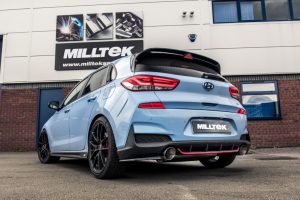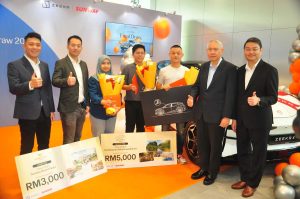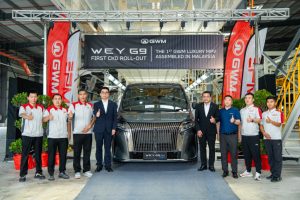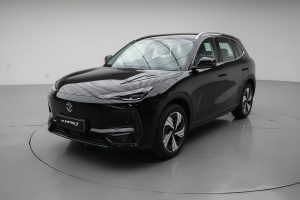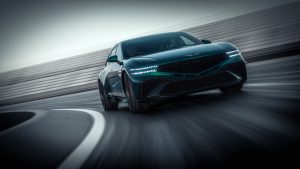Honda Malaysia has registered almost 3,300 units of the WR-V sports utility vehicles (SUV) as of the middle of this month and 62% of them were RS variants, indicating a market preference for this sporty version.
Also at the same time, the company has received some strong 7,300 bookings for this arguably “the littlest” of the Honda line-up in Malaysia.
That is hardly surprising since the market is built on the premise that Honda customers are mostly of a younger age in demographic profile and are generally outgoing and adventurous.

The WR-V (which stands for Winsome Runabout Vehicle) comes in four variants starting from S, E, V to the top-of-the-line RS.
When Honda Malaysia decided to organise a media drive in Langkawi, the company only provided the RS variant which skewed drive impressions somewhat.
We learnt during the event that the WR-V is actually tuned differently in suspension settings according to tyre sizes.

The RS with the 255/55 R17 tyres has stiffer gas dampers to provide a more stable and controlled ride through winding roads while the other offerings (S, E and V) with the 215/60 R16 tyres have softer tuned gas dampers to achieve a comfortable and more compliant ride.
Unfortunately, no other variants were provided during the Langkawi drive for us to achieve a more rounded impression of the WR-V.
As it were, the RS gave a good account of its capabilities all the same during the round island drive that took in a good mix of winding stretches with urban and country roads thrown in.

Getting into the WR-V, we noted the cosiness of the interior with adequate head, leg and elbow room.
There appeared to be slightly more interior room than the nearest rival in body dimensions, the Perodua Ativa.
The sporty touch was sensed in the use of red stitching and accents for the seats, dashboard and headrests.
Being the entry-level SUV model in Honda Malaysia’s family, the WR-V doesn’t come with electronic adjustments for the driver’s seat.

Nevertheless, we got a satisfactory driving position without taking too much of the leg space for the rear passenger.
Powering the WR-V is the widely accepted 1.5-litre double overhead camshaft i-VTEC engine that is also found in the City, City Hatchback and the now-retired BR-V model.
Despite being a normally aspirated unit, this 1.5-litre engine is among the most powerful for its displacement category – 121PS and 145Nm of torque.

Channelling the healthy engine output to the front wheels is the Continuously Variable Transmission (CVT).
An idea of the WR-V’s performance capability is reflected in Honda’s claims of a 160kph top speed, 0-100kph sprint in 11.3 seconds for the RS (the lower spec and lighter S and E variants do that in 11 seconds) and an average fuel consumption of 6.0 litres per 100km or 16.6km per litre.
Not bad for an entry-level SUV that tips the scales from 1,108kg to 1,145kg for the S to RS variants.

We could relate to that in the good initial pace and a readiness to open up on clear roads when we put our foot down on the accelerator pedal.
The CVT is much improved as the uptake of road speed was not accompanied by a loud engine revving up during the initial burst.
Don’t get us wrong; the engine rev-up is still there but is much quieter now than earlier CVT vehicles we have driven in.

This CVT note is now closer in audible pitch to that of an automatic transmission and you would not notice it after driving the SUV for a while.
We liked the way the RS took to the winding stretches at good speeds with steady poise and footing; there was minimal body roll and the electric power steering was well-tuned to give a good directional feel for confident corner-taking.
Ride comfort was within acceptable limits, especially over bumpy stretches, given the harder gas dampers and this was gauged from the rear passenger perspective.

Noise intrusion into the interior was low and this was noted during the few times we could carry some robust speed on clear straight stretches.
The 380-litre luggage space looks good for accommodating holiday paraphernalia for four and the 60:40 folding rear seats would extend space nicely for other hobby items, even a bicycle!
Other features of the RS include six airbags, front LED Sequential Turn Signals, 7-inch Display Audio with Apple CarPlay and Android Auto Connectivity, meter cluster with 4.2-inch TFT screen, Smart Entry with Push Start Button, paddle shift and a multi-angle reverse camera.

A highly useful feature is the Honda Connect which provides remote connection and convenience via a smartphone.
Some of them are making automated calls during an accident, speed alert warnings based on the speed set, security alerts with vehicle parameters setting (preventing car theft) and remote vehicle control (such as starting the vehicle from afar).
In addition, the RS also gets a Honda LaneWatch camera system and a Honda Sensing smart safety suite that consists of Lead Car Departure Notification (LCDN), Adaptive Cruise Control (ACC), Forward Collision Warning (FCW), Collision Mitigation Braking System (CMBS), Lane Keep Assist System (LKAS), Road Departure Mitigation (RDM), Lane Departure Warning (LDW) and Auto High Beam (AHB).

In looks, the RS makes a nice lifestyle statement with its flashy nose, especially the glittering grille and sleek headlamps.
At RM107,900 on the road without insurance, most Honda customers have indeed deemed the RS as good value for money and after the Langkawi drive, it’s most definitely a thumbs-up to that.

